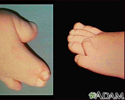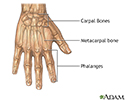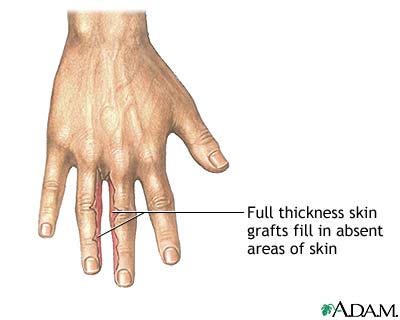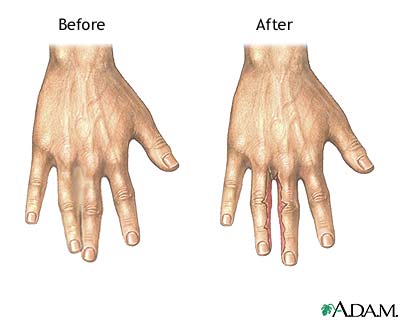Repair of webbed fingers or toes
Web finger repair; Web toe repair; Syndactyly repair; Syndactyly release
Repair of webbed fingers or toes is surgery to fix webbing of the toes, fingers, or both. The middle and ring fingers or the second and third toes are most often affected. Most often this surgery is done when a child is between 6 months and 2 years old.
Description
Surgery is done the following way:
- General anesthesia may be given. This means your child is asleep and won't feel pain. Or regional anesthesia (spinal and epidural) is given to numb the arm and hand. General anesthesia is more commonly used for younger children because it is safer to manage them while they are sleeping.
- The surgeon marks the areas of the skin that need repair.
- The skin is cut into flaps, and the soft tissues are cut to separate the fingers or toes.
- The flaps are sewn into position. If needed, skin taken (graft) from other areas of the body is used to cover places that are missing skin.
- The hand or foot is then wrapped with a bulky bandage or cast so that it can't move. This allows healing to take place.
Simple webbing of fingers or toes involves only the skin and other soft tissues. The surgery is more complicated when it involves fused bones, nerves, blood vessels, and tendons. These structures may need to be reoriented or reconstructed to allow the digits to move independently.
Why the Procedure Is Performed
This surgery is advised if the webbing causes problems with appearance, or in using or movement of the fingers or toes.
Risks
Risks of anesthesia and surgery in general include:
- Problems breathing
- Reactions to medicines
- Bleeding, blood clot, or infection
Other possible complications related to this surgery include the following:
- Damage from not getting enough blood in the hand or foot
- Loss of skin grafts
- Stiffness of the fingers or toes
- Injuries to the blood vessels, tendons, or bones in the fingers
Contact your provider if you notice the following:
- Fever
- Fingers that tingle, are numb, or have a bluish tinge
- Severe pain
- Swelling
Before the Procedure
Tell your child's surgeon what medicines your child is taking. This includes medicines, supplements, or herbs you bought without a prescription.
- Ask your child's surgeon which medicines you should still give your child on the day of the surgery.
- Let the surgeon know right away when your child has any cold, flu, fever, herpes breakout, or other illness before the surgery.
On the day of the surgery:
- You will likely be asked not to give your child anything to eat or drink 6 to 12 hours before the procedure.
- Give your child any medicines the doctor told you to give with a small sip of water.
- Be sure to arrive at the hospital on time.
After the Procedure
A hospital stay of 1 to 2 days is usually needed.
Sometimes the cast extends beyond the fingers or toes to protect the repaired area from injury. Small children who had webbed finger repair may need a cast that reaches above the elbow.
After your child goes home, call the surgeon if you notice the following:
- Fever
- Fingers that tingle, are numb, or have a bluish tinge
- Severe pain (your child may be fussy or constantly crying)
- Swelling
Outlook (Prognosis)
The repair is usually successful. When joined fingers share a single fingernail, the creation of two normal-looking nails is rarely possible. One nail will look more normal than the other. Some children require a second surgery if the webbing is complicated.
The separated fingers will never look or function the same.
References
Mauck BM. Congenital anomalies of the hand. In: Azar FM, Beaty JH, eds. Campbell's Operative Orthopaedics. 14th ed. Philadelphia, PA: Elsevier; 2021:chap 80.
McCombe DB, Soldado F. Deformities of the hand and fingers. In: Wolfe SW, Pederson WC, Kozin SH, Cohen MS. Green's Operative Hand Surgery. 8th ed. Philadelphia, PA: Elsevier; 2022:chap 36.
Before and after webbed finger repair - illustration
Before and after webbed finger repair
illustration
Syndactyly - illustration
Syndactyly
illustration
Repair of webbed fingers - series
Presentation
Review Date: 9/20/2022
Reviewed By: C. Benjamin Ma, MD, Professor, Chief, Sports Medicine and Shoulder Service, UCSF Department of Orthopaedic Surgery, San Francisco, CA. Also reviewed by David C. Dugdale, MD, Medical Director, Brenda Conaway, Editorial Director, and the A.D.A.M. Editorial team.










